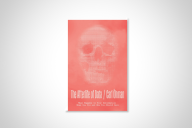You have /5 articles left.
Sign up for a free account or log in.
Jerome Karabel's The Chosen is the big meta-academic book of the season -- a scholarly epic reconstructing "the hidden history of admission and exclusion at Harvard, Yale, and Princeton," as the subtitle puts it. Karabel, who is a professor of sociology at the University of California at Berkeley, has fished documents out of the archive with the muckraking zeal worthy of an investigative journalist. And his book, published this month by Houghton Mifflin, is written in far brisker narrative prose than you might expect from somebody working in either sociology or education. That's not meant as a dis to those worthy fields. But in either, the emphasis on calibrating one's method does tend to make storytelling an afterthought.
For Karabel really does have a story to tell. The Chosen shows how the gentlemanly anti-Semitism of the early 20th century precipitated a deep shift in how the country's three most prestigious universities went about the self-appointed task of selecting and grooming an elite.
It is (every aspect of it, really) a touchy subject. The very title of the book is a kind of sucker-punch. It is an old anti-Jewish slur, of course. It's an allusion to Jehovah's selection of the Jews as the Chosen People, of course. It's also a term sometimes used, with a sarcastic tone, as an ethnic slur. But Karabel turns it back against the WASP establishment itself -- in ways too subtle, and certainly too well-researched, to be considered merely polemical. (I'm going to highlight some of the more rancor-inspiring implications below, but that is due to my lack of Professor Karabel's good manners.)
The element of exposé pretty much guarantees the book a readership among people fascinated or wounded by the American status system. Which is potentially, of course, a very large readership indeed. But "The Chosen" is also interesting as an example of sociology being done in almost classical vein. It is a study of what, almost a century ago, Vilfredo Pareto called "the circulation of elites" -- the process through which "the governing elite is always in a state of slow and continuous transformation ... never being today what it was yesterday."
In broad outline, the story goes something like this. Once upon a time, there were three old and distinguished universities on the east coast of the United States. The Big Three were each somewhat distinctive in character, but also prone to keeping an eye on one another's doings.
Harvard was the school with the most distinguished scholars on its faculty -- and it was also the scene of President Charles Eliot's daring experiment in letting undergraduates pick most of their courses as "electives." There were plenty of the "stupid young sons of the rich" on campus (as one member of the Board of Overseers put it in 1904), but the student body was also relatively diverse. At the other extreme, Princeton was the country club that F. Scott Fitzgerald later described in This Side of Paradise. (When asked how many students there were on campus, a Princeton administrator famously replied, "About 10 percent.")
Finally, there was Yale, which had crafted its institutional identity as an alternative to the regional provincialism of Harvard, or Princeton's warm bath of snobbery. It was "the one place where money makes no difference ... where you stand for what you are," in the words of the then-beloved college novel Dink Stover, about a clean-cut and charismatic Yalie.
But by World War One, something was menacing these idyllic institutions: Namely, immigration in general and "the Hebrew invasion" in particular. A meeting of New England deans in the spring of 1918 took this on directly. A large and growing percentage of incoming students were the bright and driven children of Eastern European Jewish immigrants. This was particularly true at Harvard, where almost a fifth of the freshman class that year was Jewish. A few years later, the figure would reach 13 percent at Yale -- and even at Princeton, the number of Jewish students had doubled its prewar level.
At the same time, the national discussion over immigration was being shaped by three prominent advocates of "scientific" racism who worried about the decline of America's Nordic stock. They were Madison Grant (Yale 1887), Henry Fairfield Osborne (Princeton 1877), and Lothrop Stoddard (Harvard 1905).
There was, in short, an air of crisis at the Big Three. Even the less robustly bigoted administrators worried about (as one Harvard official put it) "the disinclination, whether justified or not, on the part of non-Jewish students to be thrown into contact with so large a proportion of Jewish undergraduates."
Such, then, was the catalyst for the emergence, at each university, of an intricate and slightly preposterous set of formulae governing the admissions process. Academic performance (the strong point of the Jewish applicants) would be a factor -- but one strictly subordinated to a systematic effort to weigh "character."
That was an elusive quality, of course. But administrators knew when they saw it. Karabel describes the "typology" that Harvard used to make an initial characterization of applicants. The code system included the Boondocker ("unsophisticated rural background"), the Taconic ("culturally depressed background," "low income"), and the Krunch ("main strength is athletic," "prospective varsity athlete"). One student at Yale was selected over an applicant with a stronger record and higher exam scores because, as an administrator put it, "we just thought he was more of a guy."
Now, there is a case to be made for a certain degree of flexibility in admissions criteria. If anything, given our reflex-like tendency to see diversity as such as an intrinsic good, it seems counterintuitive to suggest otherwise. There might be some benefit to the devil's-advocate exercise of trying to imagine the case for strictly academic standards.
But Karabel's meticulous and exhaustive record of how the admissions process changed is not presented as an argument for that sort of meritocracy. First of all, it never prevailed to begin with.
A certain gentlemanly disdain for mere study was always part of the Big Three ethos. Nor had there ever been any risk that the dim sons of wealthy alumni would go without the benefits of a prestigious education.
What the convoluted new admissions algorithms did, rather, was permit the institutions to exercise a greater -- but also a more deftly concealed -- authority over the composition of the student body.
"The cornerstones of the new system were discretion and opacity," writes Karabel; "discretion so that gatekeepers would be free to do what they wished and opacity so that how they used their discretion would not be subject to public scrutiny.... Once this capacity to adapt was established, a new admissions regime was in place that was governed by what might be called the 'iron law of admissions': a university will retain a particular admissions policy only so long as it produces outcomes that correspond to perceived institutional interests."
That arrangement allowed for adaptation to social change -- not just by restricting applicants of one minority status in the 1920s, but by incorporating underrepresented students of other backgrounds later. But Karabel's analysis suggests that this had less to do with administratorsbeing "forward-looking and driven by high ideals" than it might appear.
"The Big Three," he writes, "were more often deeply conservative and surprisingly insecure about their status in the higher education pecking order.... Change, when it did come, almost always derived from one of two sources: the continuation of existing policies was believed to pose a threat either to vital institutional interests (above all, maintaining their competitive positions) or to the preservation of the social order of which they were an integral -- and privileged -- part."
Late in the book, Karabel quotes a blistering comment by the American Marxist economist Paul Sweezy (Exeter '27, Harvard '31, Harvard Ph.D. '37) who denounced C. Wright Mills for failing to grasp "the role of the preparatory schools and colleges as recruiters for the ruling class, sucking upwards the ablest elements of the lower classes." Universities such as the Big Three thus performed a double service to the order by "infusing new brains into the ruling class and weakening the potential leadership of the working class."
Undoubtedly so, once upon a time -- but today, perhaps, not so much. The neglect of their duties by the Big Three bourgeoisie is pretty clear from the statistics.
"By 2000," writes Karabel, "the cost of a year at Harvard, Yale, and Princeton had reached the staggering sum of more than $35,000 -- an amount that well under 10 percent of American families could afford....Yet at all three institutions, a majority of students were able to pay their expenses without financial assistance -- compelling testimony that, more than thirty years after the introduction of need-blind admissions, the Big Three continued to draw most of their students from the most affluent members of society." The number of students at the Big Three coming from families in the bottom half of the national income distribution averages out to about 10 percent.
All of which is (as the revolutionary orators used to say) no accident. It is in keeping with Karabel's analysis that the Big Three make only as many adjustments to their admissions criteria as they must to keep the status quo ante on track. Last year, in a speech at the American Council on Education, Harvard's president, Larry Summers, called for preferences for the economically disadvantaged. But in the absence of any strong political or social movement from below -- an active, noisy menace to business as usual -- it's hard to imagine an institutionalized preference for admitting students from working families into the Big Three. (This would have to include vigorous and fairly expensive campaigns of recruitment and retention.)
As Walter Benn Michaels writes in the latest issue of N+1 magazine, any discussion of class and elite education now is an exercise in the limits of the neoliberal imagination. (His essay was excerpted last weekend in the Ideas section of The Boston Globe.
"Where the old liberalism was interested in mitigating the inequalities produced by the free market," writes Michaels, " neoliberalism -- with its complete faith in the beneficence of the free market -- is interested instead in justifying them. And our schools have a crucial role to play in this. They have become our primary mechanism for convincing ourselves that poor people deserve their poverty, or, to put the point the other way around, they have become our primary mechanism for convincing rich people that we deserve our wealth."
How does this work? Well, it's no secret that going to the Big Three pays off. If, in theory, the door is open to anyone smart and energetic, then everything is fair, right? That's equality of opportunity. And if students at the Big Three then turn out to be drawn mainly from families earning more than $100,000 per year....
Well, life is unfair. But the system isn't.
"But the justification will only work," writes Michaels, if "there really are significant class differences at Harvard. If there really aren't -- if it's your wealth (or your family's wealth) that makes it possible for you to go to an elite school in the first place -- then, of course, the real source
of your success is not the fact that you went to an elite school but the fact that your parents were rich enough to give you the kind of preparation that got you admitted to the elite school. The function of the (very few) poor people at Harvard is to reassure the (very many) rich people at Harvard that you can't just buy your way into Harvard."








